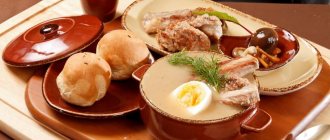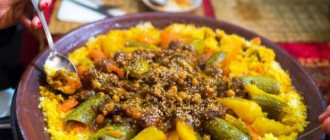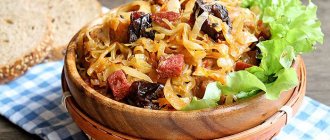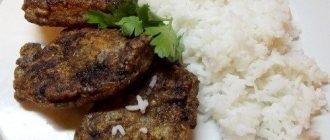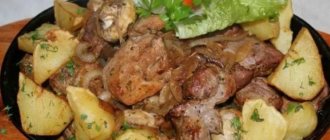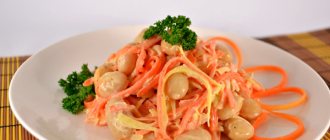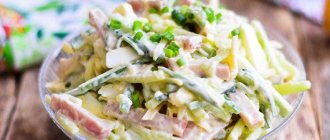Updated 29/10/2020
Every second first-time tourist who comes to Hungary wonders what to eat in Budapest. The country's national cuisine is rich and original; it is based on meat, onions and paprika, and is also distinguished by a huge number of dishes that combine the first and second. It’s no wonder that an inexperienced gourmet can easily get lost in a large number of items that have not yet been translated into English or Russian. Therefore, I decided to help you navigate the diversity of Hungarian cuisine, and at the same time tell you about the most remarkable dishes that are definitely worth trying.
Features of national cuisine
Hungarian cuisine is famous for its huge variety of recipes. The dishes are usually very filling and nutritious. The uniqueness of this national cuisine can be summarized by the following characteristics:
- Hungarian cuisine often combines the first and second courses, such as roast, goulash, lecho, etc.
- Often a recipe may include several types of meat. Hungarian cuisine uses pork, beef, chicken, veal, lamb, goose, rabbit, duck and wild boar.
- In addition to meat, national cuisine boasts the addition of lard.
- Almost all Hungarian dishes are seasoned with paprika and onions.
- Game, which is cooked by stewing or fried, is especially popular. Served with thick sauce.
- Among fish dishes, it is worth noting khalasle fish soup, which is cooked from several varieties of fish with the addition of paprika, tomatoes and onions. This is another option for combining the first and second courses.
- Each dish is traditionally served with a glass of wine, such as Hungarian vermouth. Apricot vodka can also be used as an aperitif.
- Hungarian cuisine often uses seasonal vegetables and fruits, dairy products, and various cheeses. Special respect for freshly baked bread.
Hungarian cuisine: food as part of culture
In Hungary there is the concept of “Hungaricum”. He describes objects and phenomena characteristic only of this country. The list includes Lake Balaton , a Rubik's cube, Nadudvar ceramics, and a good dozen dishes and food products. What kind of Hungaricum can you order for lunch?
Gulyás is the main national dish of Hungary, a thick soup with pieces of beef, paprika and potatoes. Goulash was cooked by shepherds, placing huge cauldrons over the fire.
Many restaurants honor this tradition and prepare the dish in cauldrons, which are called bogrács in Hungarian. It is under the name “bograch” that goulash is served in Ukrainian Transcarpathia .
Pörkölt – meat fried and then stewed with paprika and onions. For pörkölt, beef, pork, lamb, poultry, beef tripe, liver, and chicken gizzards are used.
Paprikás – meat stewed in sour cream, most often chicken or veal. Sometimes paprikash is made from fish.
Debreceni kolbász – smoked long sausages made from minced beef and pork with paprika. Debrecen sausages are rarely served as a separate dish, but are often added to goulash.
Tarhonya is a unique dish of Hungarian cuisine in the form of small flakes or balls of dough, a type of pasta originally from the times when the Hungarians roamed the steppe. Tarhonya is served with pörkölt and goulash: it helps not to leave a drop of tasty sauce on the plate.
Paprika is a pepper that is added to soups and meat dishes. Kalochay or Szeged paprika is especially prized. Sweet peppers are stuffed, hot peppers are used as seasoning.
Salads: a short warm-up
In Hungary, the appetizer table is not very rich: why linger over salad when you need to quickly start hot goulash? But still, salads from fresh vegetables are definitely on the menu.
Paprika, tomatoes, cucumbers, Savoy and white cabbage, lettuce, and parsley are used. But the dressing is special - rendered pork fat. The taste is very piquant, but if you don’t trust this innovation, ask to dress the salad with vegetable oil.
Hungarian soups: first and second in one plate
For a quick and satisfying meal, order one of the Hungarian soups.
- Gulyas leves - soup with paprika, lots of vegetables, beef and small dumplings (or tarjone) will replace a full lunch.
- Jokai bableves is a thick and rich bean soup containing pork knuckle and smoked sausage.
- Halasz leves, or halászlé , is a traditional Hungarian freshwater fish soup. You can try especially delicious fish soup on Lake Balaton, where it is prepared from freshly caught fish.
- Főzelék is the lightest of the Hungarian soups. Puréed vegetables are seasoned with a sauce made from flour and sour cream, and a boiled egg, meatballs or croutons are added to the finished dish.
- Ujhazi is a regular chicken broth seasoned with vegetables and noodles.
Second courses: for the hungriest
It's not easy to draw the line here. Soups and meat dishes usually contain equal parts meat and vegetables, so the division will be conditional.
- Marha pörkölt – beef pörkölt, one of the most popular dishes in Hungary. It is customary to serve not porridge or potatoes with pörkölt, but tarhonya.
- Tokány is a variation of pörkölt, but the meat for it is cut into thin strips. Tokan is more common not in Hungary itself, but in Romanian Transylvania and the Transcarpathian region of Ukraine.
- Paprikás borju – tender veal paprikash.
- Paprikás csirke – chicken paprikash.
- Toltott paprika – stuffed paprika, a hearty and at the same time beautiful dish. There are no surprises here, except that the rice in the minced meat is sometimes replaced with tarragon.
- Töltött káposzta – stuffed cabbage, that is, simply cabbage rolls.
- Lecsó is a dish typical of Hungarian cuisine. Can you guess what it contains? Of course, meat and paprika, and also onions and tomatoes. The meat in this dish is represented by smoked sausages, and in addition to sweet paprika, hot pepper is definitely added to the plate.
Meat-free dishes: does it happen? Imagine, meat-eating Hungarians sometimes eat dishes made from vegetables and pasta. The choice of their dishes is, of course, smaller.
- Paprikás krumpli – potatoes stewed with paprika. Sometimes sausage is added to it.
- Rakott krumpli – potato casserole. It consists of hard-boiled eggs and (as without it!) sausage.
- Csusza – pasta casserole. Chusa with poppy seeds is called makoscsusza, with cottage cheese - turoscsusza, with walnuts - dioscsusza.
Snacks: when you urgently need to eat
Sometimes you should prefer a simple, but original one to a complex dish.
Lángos is a fried flatbread, the most popular Hungarian fast food dish. True, lángos is fried in boiling oil, but spread with sour cream and garlic or sprinkled with grated cheese, it is delicious. This flatbread can sometimes be eaten in the morning instead of breakfast.
Bundás kenyér - pieces of bread dipped in an egg-milk mixture and fried in oil. If you spread them with honey or jam, you will get an excellent addition to tea.
Körözött is an unsweetened curd paste that Hungarians themselves love very much. Pasta comes with various additives (dill, paprika, smoked meats). Just spread this yummy on bread, and a quick breakfast is ready.
What to try from Hungarian cuisine if you are going to travel around the country?
Debreceni páros kolbász – large and flavorful Debrecen sausages. The minced meat for them is made from pork and beef and flavored with paprika, garlic and cumin.
Miskolci kocsonyа is jellied meat, for which a festival is even held in the city of Miskolc-Tapolca.
Jellied meat in Miskolc has long ceased to be just a dish of meat and congealed broth: chefs have come up with many ways to prepare and serve it - for example, in dense cubes rolled in spices, it is difficult to recognize ordinary jelly. And by the way, we need to check why people in the city say: “It blinks like a frog in aspic.”
Hortobágyi húsos palacsinta – Hortobágy pancakes with meat filling, which are prepared near Hajdúszoboszló, in Hortobágy Puszta. Before serving, pancakes are baked in the oven with sour cream and paprika sauce.
- What to bring from Hungary as a gift: the best ideas for children and adults
Desserts: those with a sweet tooth, come on over!
Hungarian desserts make your mouth water, even if you've had a big meal before. But before licking your lips at complex high-calorie cakes, please your child with simple pastries.
Kürtőskalács are a crispy golden tube sprinkled with sugar, vanilla, cinnamon, nuts and other all sorts of goodies. There is no filling in it, and it is not needed: the dough itself is very tasty. The tubes are baked in street tents over coals, and it is best to eat this delicacy warm - especially since kürtöskalács are always sold at Christmas markets.
For the main Hungarian sweet, marzipan, you can go to a regular store or to one of the marzipan museums. It's amazing that a mixture of ground almonds and powdered sugar can be so delicious.
Somlói galuska is a traditional dish in Hungary that has nothing to do with dumplings. This is a dessert made from slices of nut and chocolate sponge cake topped with whipped cream. Shomloy dumplings can be served in a bowl or in the form of a cake, and raisins or prunes are sometimes added to the delicacy.
Rétes is a roll that is very reminiscent of Austrian strudel. The filling for it is made from apples, cherries, cottage cheese, poppy seeds, and nuts.
Rigó Jancsi is a cake made from two pieces of sponge cake, between which there is a thick layer of chocolate mousse.
Gundel palacsinta – Gundel pancakes. Your child will appreciate Károly Gundel's contribution to the national cuisine of Hungary: you will be surprised how quickly the plate becomes empty. But it is worth keeping in mind that this dessert is prepared in pork fat, which is why it turns out to be as high in calories as many Hungarian dishes.
Túrós gombóc - curd balls boiled in water and poured with sweet syrup (sometimes a sweet filling is placed inside the balls).
Gourmets praise two famous Hungarian cakes, Dobos and Esterhazy . It is advisable to take a small piece of each of the cream cakes... and then order another large piece.
Dobostorta is a cake made from thin sponge cakes, coated with chocolate cream and topped with caramel glaze. It has been baked for the second hundred years, and it is on the list of the most popular desserts in Hungary.
Eszterházy torta is an almond-chocolate cake decorated with a special spider web design. The dessert was named after Hungarian Foreign Minister Pal Esterhazy.
At Christmas in Hungary, it is customary to bake bagels - rolls made from yeast dough with poppy seeds and nuts.
Drinks: unique “Tokai” and more
When talking about Hungarian drinks, the first thing people mention is wine.
- Egri bikavér is a dry red wine that goes well with hearty meat dishes.
- Száraz Tokaji Szamorodni, Tokaji aszu – dessert wines, a good end to the meal.
- Pálinka is a brandy made from grapes, apricots and other fruits. The best grape palinka is produced in Tokaj, the city of Kecskemét is famous for its apricot palinka.
- Unicum – herbal balm. It is believed that the name was given to it by Emperor Joseph II, for whom the drink was created. The emperor liked the taste of the balm so much that he exclaimed: “Das ist ein Unikum!”
The most popular soft drink in Hungary is coffee (kávé) . They drink it often and a lot. Tea is ordered less often, and therefore cafes usually brew tea in bags. But Hungarian mineral water is a medicinal drink, not a table drink. There is no need to quench their thirst.
- What to eat in Hungary and how much does it cost?
Hungarian goulash
This is a world famous dish. Goulash is a kind of thick soup. The basic ingredients are beef or veal, smoked pork lard, potatoes, sweet red peppers, tomatoes, flour, spices, including paprika. Initially, the recipe was invented by shepherds and cattle drivers who cooked goulash in a cauldron over a fire built in the pastures.
Preparing the dish is quite simple. The meat is cut into slices and fried with lard. Then all the ingredients are mixed in a deep saucepan and cooked until tender. The highlight of the dish is in its presentation. Goulash is often served in bread pots or in clay dishes. This rustic serving style makes the dish even more appetizing.
Hungarian desserts and sweets
Hungarian desserts and sweets delight everyone with a sweet tooth. Even those who don’t really like sweets will like them. These include a variety of complex cakes, crispy rolls, delicious cookies and much more. The main Hungarian sweet, which is known throughout the world, is marzipan. People come from different parts of the world to taste this delicious dish.
Kürtöskalács is no less popular in Hungary. This is the name given to crispy tubes that are sprinkled with cinnamon, sugar, nuts or vanilla. They have a golden hue. There is no filling in this dessert, but there is no need for it. The food is usually sold in street stalls, where delicious rolls are prepared directly over the fire. The delicacy is also a mandatory attribute of the Christmas holidays.
Another interesting dessert is somloi dumplings. This is not dumpling at all, but a delicious sponge cake with nuts and chocolate, which is topped with whipped cream before serving. The dish is usually a cake or pieces of it, served in a bowl. Practical housewives often include prunes or raisins in their ingredients.
Retes is a dish that is very similar to Austrian strudel. The filling for the roll can be poppy seeds, cherries, apples, nuts and cottage cheese. Another popular dessert in Hungary is Rigo Jansi. This is the name for sponge cake with chocolate mousse cream.
Children love pancakes, so you can prepare palacinta gundel for them. Usually the food is sprinkled with powdered sugar or vanilla and complemented with chocolate. Keep in mind that these pancakes are fried in pork fat, so they are quite high in calories, just like all Hungarian dishes. Kids will also like turos gombok, which is a cottage cheese ball with sweet syrup. Usually a dish without filling.
Gourmets prefer the Hungarian Esterhazy and Dobos cakes, which are rich in cream. Another hearty cake is Dobostorta. It is based on thin sponge cakes, chocolate cream and caramel glaze. This dessert is included in the ranking of the most popular in the world. The estezhazhi cake cake, which has an almond-chocolate flavor and a beautiful spider web design, is also in demand.
During the holidays, especially Christmas, Hungarians make bagels. These are delicious rolls made from yeast dough, supplemented with nuts and poppy seeds.
Chicken paprikash
Another hallmark of Hungarian cuisine. The dish can also be classified as “thick soup” or “stew”.
In the old days, paprikash was prepared from old chickens to make the food richer. In a modern interpretation of the dish, chicken breast and legs are used.
The meat is fried in oil. Remove from heat. Peppers, onions, and garlic are fried in the resulting fat. Then put all the ingredients in one bowl, add spices and always sour cream. Add a little flour for thickness.
Paprikash is traditionally served with dumplings or pasta. The dish can be prepared not only from chicken, but also from other meats.
Secrets of the national cuisine of Hungary
Using various products in one dish, the country's best chefs achieve a variety of flavor combinations:
- Animal fat is used in heat treatment of food and almost no oil is used. In pork, the qualities of onion and paprika are fully revealed.
- A large number of spices and herbs give the food piquancy and pungency.
- Sour cream is present in many soups, sauces, and meat dishes.
In Hungary, food is often prepared in various pots. Stewing and simmering foods, so beloved by Hungarian chefs, gives dishes a special aroma and unforgettable taste.
Wiener Schnitzel
The dish consists of a thin layer of meat, which is lightly beaten before cooking. For schnitzel, pork or veal is most often used; there are also recipes with turkey and other meats.
The product is dipped in flour, beaten egg and breadcrumbs, and then fried in a large amount of oil. For Wiener schnitzel, a large piece of meat is used, sometimes even larger than a medium-sized plate.
Schnitzel is served with a side dish, such as potatoes in different variations (fried, boiled, fries). A vegetable salad also goes well with meat. A slice of lemon is often served with meat.
Property of the Republic
What to try first from the national cuisine of Hungary? Of course, goulash. Gulyás is translated from Hungarian as “shepherd”. This is because this thick soup was originally the food of shepherds. They went far into the fields, sometimes for several days. And when it was time for lunch, they set up the pots and simmered a thick stew of veal and beef with pieces of potatoes.
Today goulash is the main gastronomic treasure. Every year in September in the small town of Szolnok, 85 km from Budapest, a festival dedicated to this dish is held. Goulash is prepared in the field in huge cauldrons, and an unimaginable aroma floats throughout the area. Instead of a cauldron, we will take a cauldron or a large deep frying pan with a thick bottom.
Ingredients:
- beef shoulder - 700 g
- potatoes - 3-4 pcs.
- onions 2–3 pcs.
- garlic - 2 cloves
- bell pepper - 1 pc.
- hot pepper - 1 pod
- paprika - 3 tbsp. l. with a slide
- cumin - 1 tsp.
- lard - for frying
- salt, black pepper, hot pepper - to taste
- fresh parsley and green onions - for serving
Melt all the fat from the lard in a large deep frying pan, remove the cracklings. Cut the beef into strips and fry on all sides until golden brown over high heat. Then pour the onion into cubes, reduce the flame to medium, fry for a few more minutes, add crushed garlic and cumin. Cut the sweet pepper into strips, add to the meat along with the paprika, and mix gently. Fill everything with hot water or broth so that the meat is covered by 2-3 cm. Now add potatoes in large cubes and hot pepper rings.
Cover the pan with a lid, reduce the flame to low and simmer for 35–40 minutes. Be sure to let the goulash rest for another quarter of an hour under the lid. And then serve it immediately, garnishing each serving with fresh parsley or green onions.
Beverages
Hungarian cuisine is also famous for various liqueurs, liqueurs, balms and other tinctures. Among the most popular alcoholic drinks it is worth noting:
- apricot vodka. It's a kind of fruit brandy. It is also called palinka;
- bitter "Unicum". This is a liqueur that is infused with more than 40 herbs and in special oak barrels. Has a bitter taste;
- beer. The most popular malt products made from;
- white Tokaj wine. This is the name for drinks made from special white grape varieties.
Hungarian cuisine has many interesting dishes to offer. They will all be filling and very tasty. National cuisine will delight lovers of spicy, spicy food and more. Hungarian cuisine ranks third in terms of variety of recipes, so every gourmet will find a dish for himself.
What is a must-try in Budapest?
You can go to a restaurant of Hungarian cuisine, try the delicacies of this cuisine in Moscow, St. Petersburg, or another city. But if you get the opportunity, go to Hungary to fully appreciate all its advantages.
Local cuisine includes a huge number of dishes. Among them there are the most popular ones, which clearly reflect the features of this cooking. In restaurants and cafes in Budapest, be sure to try:
- snacks - stuffed peppers, spring rolls, Debrecen sausages, goose liver pate;
- first – ukha kholasle, goulash;
- second – paprikash, lecho, perkelt, Transylvanian cabbage rolls, roast;
- desserts – kertosh, Hungarian cheesecake, strudel.
Be sure to try the Hungarian fast food - lángos. This is a flavorful, hearty deep-fried flatbread. Garlic sauce and sour cream are used for greasing; grated cheese is sprinkled on top.
In Hungary, it is customary to serve a certain drink with each meal. There are many of them, but you definitely need to try Tokaji wine in Budapest.
Other soups
While traveling around the country, you can try new hot Hungarian dishes every day:
- lamb leg soup with horseradish;
- Uykhazi soup with mushrooms and chicken scallops;
- “palots” lamb soup with bacon;
- vegetable soup with green beans;
- chorba soup with mint and garlic;
- milk soup with dumplings and cauliflower;
- creamy spinach soup.
5 soups you need to try in Hungary
Potato Gombians
We continue to learn how to cook Hungarian dishes (recipes are presented in this article). Let's make Gombovites. We will need:
- Wheat flour - one glass.
- Cinnamon - a teaspoon.
- Potatoes 4-5 pieces.
- Water - three to four glasses.
- Salt - to taste.
- Egg - two pieces.
- Granulated sugar - half a glass.
- Sunflower oil - a tablespoon.
- Cherry - one full glass. You can use cherry jam.
Sequencing:
Cooking time: five to seven minutes. Serve with sour cream or your favorite sauce.
Főzelek
Főzelék is an original Hungarian thick vegetable stew. For its preparation, zucchini, spinach, eggplant, peppers, kohlrabi, lentils and cabbage are traditionally used. Everything is cut into small pieces and stewed. Before serving, add grated potatoes or flour with sour cream to the food.
To add thickness and a special taste, some restaurants in Budapest add chipette to the dish. Fözelek is most often served with boiled or fried eggs, fresh or fried onions. Hungarian stewed meat is often added to it.
This unusual dish in Budapest is on the menu of 0.75 bistro (Szent Istvan ter, 6) and many other cafes and restaurants.
Fried pears with caramel sauce
We invite you to learn how to cook a simple and tasty Hungarian dish. This won't be difficult at all. Not only adults, but also children love juicy and ripe pears. What if you try to fry them? How about serving it with caramel sauce? An unexpected decision, but the dessert turns out very tender and incredibly tasty. Let's list the ingredients we need:
- pears (you can take a kilogram or even more),
- butter - two to three tablespoons,
- granulated sugar - one glass,
- cream - four tbsp. l.,
- salt - one glass,
- water - two tablespoons.
Steps:
Somlói galuska
Even a tourist with a sweet tooth will find something to eat in Hungary. Somlói galuska is one of the most popular and beloved local desserts. According to legend, a wonderful recipe was invented in the middle of the 20th century by a simple waiter.
Despite the not-so-exquisite name, the dessert is a real confectionery masterpiece: sponge cake soaked in rum, whipped cream and orange zest, vanilla custard, chocolate, berries, nuts, dried fruits. There are many recipes in Hungary, but each one is truly amazing!
The classic serving of Somlói galuska is in the form of small lumps, taken with a spoon from a large pie from a common plate.
To try the famed dessert in Budapest, try Hungarikum Bisztro (Steindl Imre utca, 13) or Bite Bakery Café (Terez körút, 62). But in principle it is almost everywhere.
Cheesecake
If you cannot feed your child cottage cheese, then just try making this dessert. You will need:
- Cottage cheese - 300-400 grams.
- Wheat flour - ten tablespoons.
- Egg - three pieces.
- Soda - half a teaspoon.
- Granulated sugar - 250 grams.
- Butter - two to three tablespoons.
- Sour cream - half a glass.
- Semolina - two teaspoons.
Let's get started:

